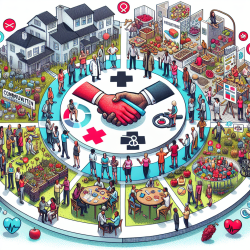Introduction
In the realm of public health, understanding the intricate patterns of risk factors within communities is crucial. The research article titled "Community-Engaged Modeling of Geographic and Demographic Patterns of Multiple Public Health Risk Factors" provides a groundbreaking methodology that combines spatial microsimulation with community engagement to address this need. This approach not only identifies high-risk subpopulations but also empowers communities to implement targeted interventions.
Understanding the Research
The study focused on New Bedford, Massachusetts, a city facing numerous public health challenges. By leveraging spatial microsimulation, researchers constructed a synthetic population dataset that reflects high-resolution demographic patterns. This dataset was then used to build regression models predicting health behaviors such as exercise, fruit and vegetable consumption, and diabetes prevalence.
Key findings revealed that lower income and educational attainment were associated with lower rates of health-promoting behaviors and higher rates of diabetes. These insights allowed community partners to identify specific census tracts with elevated risk, enabling targeted intervention strategies.
Practical Applications for Practitioners
Practitioners can enhance their skills by integrating the outcomes of this research into their practice. Here are some actionable steps:
- Utilize Spatial Data: Incorporate geographic information systems (GIS) to map health risk factors within your community. This visual representation can guide resource allocation and intervention planning.
- Engage Community Partners: Collaborate with local organizations to identify high-priority health outcomes. This partnership ensures that interventions are community-driven and culturally relevant.
- Focus on High-Risk Areas: Use data-driven insights to prioritize interventions in census tracts with higher risk profiles. Tailor programs to address the specific needs of these populations.
Encouraging Further Research
While this study provides a robust framework, further research is encouraged to refine and expand its application. Practitioners can explore the following areas:
- Broaden Geographic Scope: Apply the spatial microsimulation methodology to other communities to identify unique health challenges and intervention opportunities.
- Incorporate Additional Variables: Expand the dataset to include more predictors of health behaviors, such as environmental factors and psychosocial influences.
- Evaluate Intervention Outcomes: Conduct longitudinal studies to assess the effectiveness of interventions informed by this research.
Conclusion
By adopting the community-engaged modeling approach, practitioners can significantly enhance public health efforts within their communities. This methodology not only identifies high-risk populations but also empowers communities to implement targeted interventions that address their unique needs.
To read the original research paper, please follow this link: Community-Engaged Modeling of Geographic and Demographic Patterns of Multiple Public Health Risk Factors.










